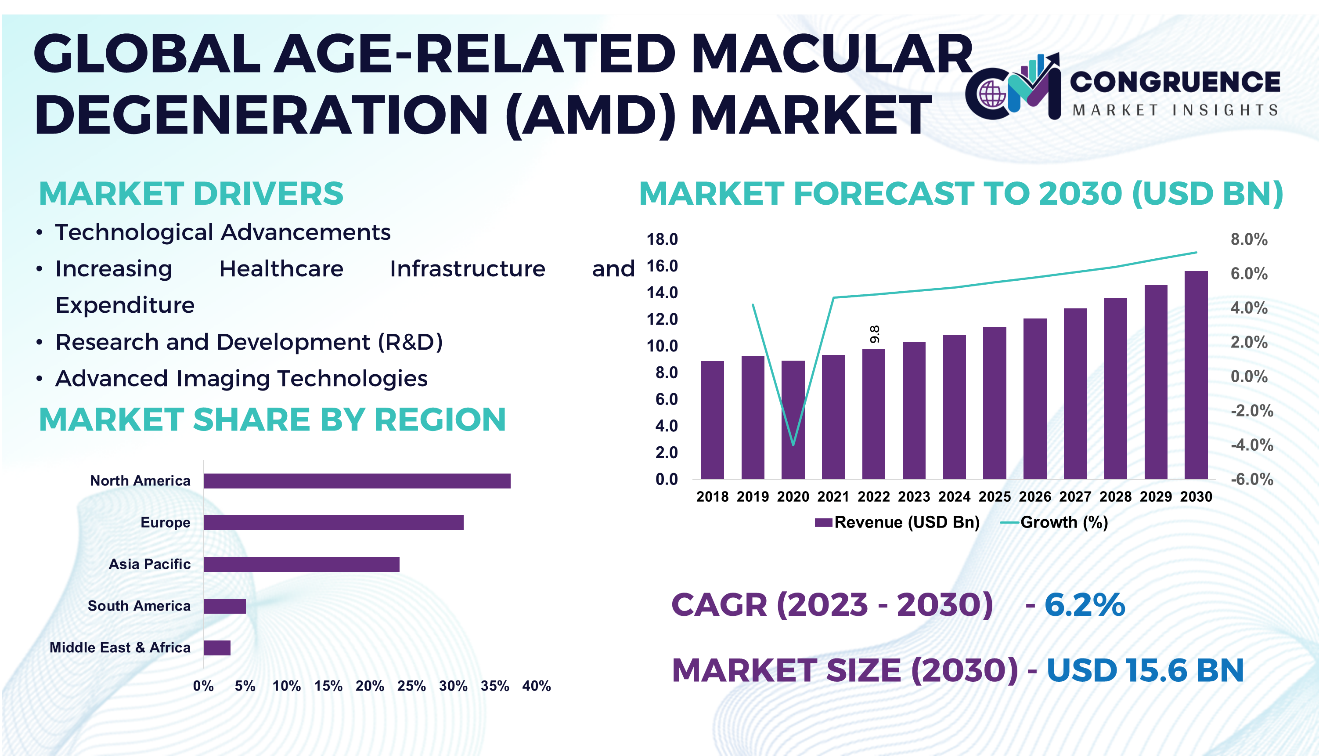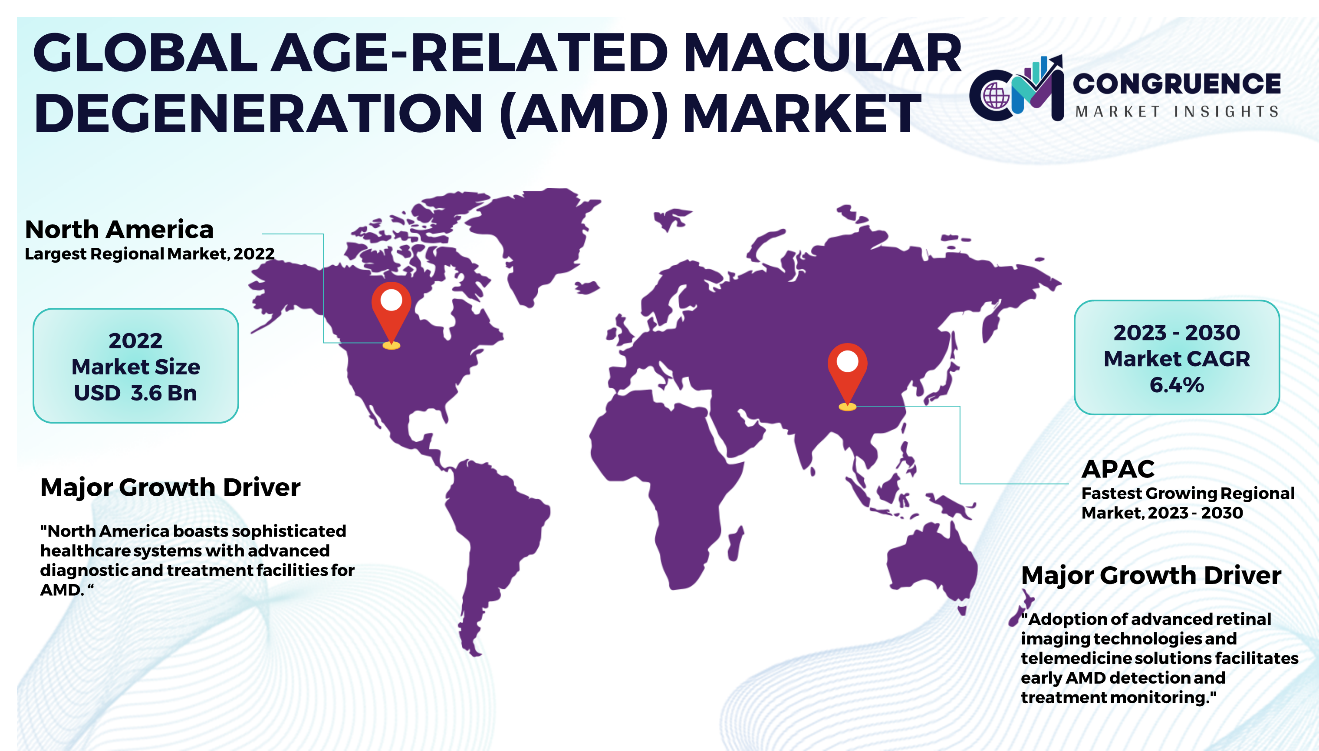Reports
The Global Age-Related Macular Degeneration (AMD) Market was valued at USD 9.8 Billion in 2022 and is anticipated to reach a value of USD 15.6 Billion by 2030 expanding at a CAGR of 6.2% between 2023 and 2030.
The Age-Related Macular Degeneration (AMD) market is experiencing notable advancements backed up by the adoption and integration of technology, particularly in retinal surgery and treatment methodologies. Innovations in medical technology, such as anti-VEGF therapy and photodynamic therapy, are reshaping approaches to AMD treatment. Additionally, the escalating prevalence of AMD, attributed to demographic aging and lifestyle factors, underscores the imperative for efficacious interventions. With the advent of advanced diagnostic modalities like optical coherence tomography (OCT) and the emergence of novel drug delivery systems, the AMD market is poised for expansion.

To learn more about this report, request a free sample
copy
Age-Related Macular Degeneration (AMD) Market Major Driving Forces
Technological Advancements: Advances in diagnostic tools and treatment modalities revolutionize the management of AMD. Technologies such as optical coherence tomography (OCT), which delivers detailed cross-sectional images of the retina, and anti-VEGF therapy, that inhibits abnormal blood vessel growth in the retina, have transformed AMD management, improving patient outcomes and quality of life.
Increasing Healthcare Infrastructure and Expenditure: The rising healthcare expenditure, particularly in developed countries with aging populations, supports greater access to AMD treatments. This investment enables patients to benefit from innovative therapies, including intravitreal injections of anti-VEGF agents, which have become a cornerstone in the treatment of neovascular (wet) AMD.
Research and Development (R&D): Growth in research efforts aim to deep understanding of AMD pathophysiology and develop novel therapeutic approaches. Emerging areas of research include gene therapy, stem cell therapy, and neuroprotective agents, which hold promise for addressing the underlying mechanisms of AMD and potentially slowing or preventing disease progression.
Advanced Imaging Technologies: Modern equipment integrates sophisticated imaging technologies such as spectral-domain optical coherence tomography (SD-OCT) and fundus autofluorescence (FAF) imaging. These non-invasive imaging modalities provide detailed, high-resolution images of the retina, enabling clinicians to detect subtle changes associated with AMD at earlier stages and monitor disease progression more effectively. Additionally, the advent of artificial intelligence (AI)-assisted image analysis enhances diagnostic accuracy and efficiency, empowering healthcare professionals to make informed treatment decisions with greater precision.
Age-Related Macular Degeneration (AMD) Market Key Opportunities
Advancements in Treatment Modalities: The refinement of treatment options offers prospects for the development of innovative therapies with enhanced efficacy and safety profiles. Opportunities arise in exploring novel drug delivery systems, gene therapies, and regenerative medicine approaches tailored to address specific AMD subtypes.
Expansion of Target Patient Population: Targeted patient demographic by identifying individuals at risk of AMD in earlier stages through comprehensive screening programs and genetic testing. This facilitates timely intervention and treatment initiation, potentially mitigating disease progression and reducing visual impairment burdens.
Personalized Medicine Approaches: Implementation of personalized medicine strategies, leveraging genetic testing and biomarker analysis, presents opportunities to tailor AMD treatment strategies to individual patient characteristics. This precision medicine approach may improve treatment outcomes and minimize adverse effects, leading to enhanced patient satisfaction and adherence.
Technological Innovations: Leveraging technological advancements, such as artificial intelligence (AI), telemedicine, and wearable devices, offers opportunities to enhance disease monitoring, patient education, and remote AMD management. These technologies enable more efficient healthcare delivery, facilitate early intervention, and foster patient engagement and compliance.
Age-Related Macular Degeneration (AMD) Market Key Trends
· The increasing adoption of anti-VEGF therapy in AMD management is aimed at suppressing abnormal blood vessel growth in the retina, a critical aspect of disease progression.
· There is a notable focus on early detection and intervention strategies, recognizing the benefits of initiating treatment promptly to prevent severe vision loss and impede disease progression.
· The incorporation of AI-powered technologies into retinal imaging and diagnostics enhances precision and effectiveness in AMD diagnosis, prognosis, and treatment planning.
· The growing utilization of telemedicine platforms facilitates remote monitoring, consultation, and follow-up care, improving access to specialized retinal healthcare services.
· Advances in genetic research supports the exploration of gene therapies targeting specific AMD-related genetic anomalies, offering sustained therapeutic benefits.
· Investigation into combination therapies, such as combining anti-VEGF agents with adjunctive treatments, aims to optimize treatment outcomes and address diverse aspects of AMD pathophysiology.
· Ongoing advances in retinal imaging technologies provide enhanced precision in visualizing AMD-related retinal changes.
· There is a strong emphasis on patient-centered care models integrating education, lifestyle modifications, and psychosocial support to improve AMD treatment outcomes and patient well-being.
· Exploration of neuroprotective agents aims to preserve retinal function and neuronal integrity, complementing existing treatments to mitigate AMD-related vision loss.
Region-wise Market Insights
North America accounted for the largest market share at 36.87% in 2022 whereas, Asia Pacific is expected to register the fastest growth, expanding at a CAGR of 6.4% between 2023 and 2030.

To learn more about this report, request a free sample
copy
North America leads in technological advancements and treatment accessibility, with a strong emphasis on personalized medicine and patient-centered care models. This will help the market's growth owing to robust healthcare infrastructure, high levels of awareness, and substantial research and development activities. Furthermore, in Europe, the AMD market is driven by stringent regulatory standards, a growing elderly population, and increasing healthcare expenditure. Asia Pacific, has been experiencing rapid growth due to expanding healthcare infrastructure, rising disposable incomes, and a large geriatric population. Meanwhile, South America and Middle East & Africa, the growth of the market is influenced by improving healthcare access, a rising prevalence of age-related diseases, and increasing awareness about eye health.
Market Competition Landscape
The Age-Related Macular Degeneration (AMD) market showcase intense competition backed by technological innovations and treatment advancements. Leading companies employ strategies like product differentiation through advanced therapeutic options and personalized medicine approaches. Research and development investments focus on novel drug delivery systems and gene therapies, while collaborative partnerships with research institutions and healthcare providers enhance market presence. Strategies also include expanding geographic reach through strategic alliances and optimized distribution networks. Marketing efforts prioritize patient education to raise awareness about AMD management and treatment options, while maintaining strict adherence to regulatory standards and quality assurance.
Key players in the global Age-Related Macular Degeneration (AMD) market implement various organic and inorganic strategies to strengthen and improve their market positioning. Prominent players in the market include:
· Novartis Pharmaceuticals Corporation
· F. Hoffmann-La Roche Ltd.
· Regeneron Pharmaceuticals Inc.
· Bayer AG
· AbbVie Inc.
· Genentech, Inc.
· Santen Pharmaceutical Co., Ltd.
· Bausch + Lomb
· Iveric Bio
· Apellis Pharmaceuticals, Inc.
· Alimera Sciences
· Kodiak Sciences Inc.
· Adverum Biotechnologies, Inc.
· Biogen
· Spark Therapeutics, Inc.
· PanOptica Pharma
|
Report Attribute/Metric |
Details |
|
Market Revenue in 2022 |
USD 9.8 Billion |
|
Market Revenue in 2030 |
USD 15.6 Billion |
|
CAGR (2023 – 2030) |
6.2% |
|
Base Year |
2022 |
|
Forecast Period |
2023 – 2030 |
|
Historical Data |
2018 to 2022 |
|
Forecast Unit |
Value (US$ Bn) |
|
Key Report Deliverable |
Revenue Forecast, Growth Trends, Market Dynamics, Segmental Overview, Regional and Country-wise Analysis, Competition Landscape |
|
Segments Covered |
· By Type (Wet AMD, and Dry AMD) · By Treatment Type (Anti-VEGF Therapy, Photodynamic Therapy, Laser Therapy, and Others) · By Diagnosis Test Type (Optical Coherence Tomography (OCT), Fluorescein Angiography, Fundus Autofluorescence, and Others) · By End User (Hospitals, Specialty Clinics, Ambulatory Surgical Centers, and Others) |
|
Geographies Covered |
North America: U.S., Canada and Mexico Europe: Germany, France, U.K., Italy, Spain, and Rest of Europe Asia Pacific: China, India, Japan, South Korea, Southeast Asia, and Rest of Asia Pacific South America: Brazil, Argentina, and Rest of Latin America Middle East & Africa: GCC Countries, South Africa, and Rest of Middle East & Africa |
|
Key Players Analyzed |
Novartis Pharmaceuticals Corporation, F. Hoffmann-La Roche Ltd., Regeneron Pharmaceuticals Inc., Bayer AG, AbbVie Inc., Genentech, Inc., Santen Pharmaceutical Co., Ltd., Bausch + Lomb, Iveric Bio, Apellis Pharmaceuticals, Inc., Alimera Sciences, Kodiak Sciences Inc., Adverum Biotechnologies, Inc., Biogen, Spark Therapeutics, Inc., PanOptica Pharma |
|
Customization & Pricing |
Available on Request (10% Customization is Free) |
